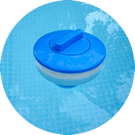
Limits for drinking water: 0.3 mg/l (ppm) as free chlorine
- Characteristic pungent odor
- Nausea of the water odor – individual sensitivity
- Eye irritation (pools)
- It damages some sensitive materials such as reverse osmosis membranes
Removal of chlorine from the water
- The principle of filtration on activated carbon
Chlorine is a proven and cost-effective disinfectant. It gets to water practically only for the purpose of disinfection. The free chlorine parameter consists of chlorine gas, but also hypochlorites, chloramines and chlorine dioxide. These substances are inherently volatile and gradually evaporate from the water. Therefore, along the water distribution network, they occur at different concentrations.
To remove free chlorine, activated carbon filters are used. Chlorine reacts quickly with the carbon and gets removed. Carbon is consumed in this process and needs to be refilled or replaced over time.
